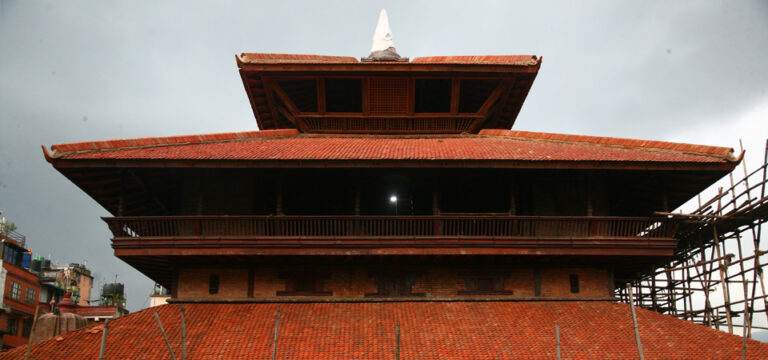
Kasthamandap, a wooden shelter, originally built in the 7th century, has finally got its original shape six years after the 2015 earthquake completely destroyed it.
Reconstruction works of the centuries-old resting place has almost completed and now it is standing again in its original shape and looks.
The three-storied shelter got its final shape after laying Jingati tiles using mud in the structure’s roofs and installing a pinnacle at the top of the third storey.
The major structural works of Kasthamandap has completed, said Gautam Dongol, secretary at the Kasthamandap Reconstruction Committee. “Only minor works on decoration of wooden parts are left to complete,” he said.
The remaining works of placing Jingati tiles will be finished before Tihar, he said.
He, however, said the committee had not fixed the inauguration date of the reconstructed Kasthamandap.
The Kasthamandap Reconstruction Committee was formed on May 1, 2018 and it started reconstruction process from July the same year.
In the last three years, the committee brought about 9228.10 cubic feet of timber in 24 installments. With the arrival of final installment of 427.65 cubic feet timber, it has now sufficient timber to complete the remaining wooden works. “Our target is to complete the remaining works before Tihar. However, small hand works of wood carving will take some time, added Dongol.
The initial estimated budget of the committee was Rs. 120 million. Kathmandu Metropolitan City (KMC) had allocated Rs. 115 million to the committee in several installments. As of now, the committee estimates that the entire project structure will complete somewhere in between Rs. 130 and Rs. 150 million.
The four major wooden posts of 14×14 inches and other 32 wooden posts of 10×10 inches were erected using manual power on the ground floor, which is divided into four layers, with each layer requiring different wooden posts of different sizes.
Altogether 100 wooden posts of four sizes were used on the ground floor. They used 32 wooden posts of 10×10 inches, 28 wooden posts of 10×10 inches, 36 wooden posts of 7×7 inches and four posts of 14×14 inches.
The Kasthmandap covers less than one ropani of land. The Committee used old bricks, stones, wood and mud to rebuild the Kasthmandap.
Historic Kasthamandap wooden shelter, Sattal, which was ravaged by the 2015.
Source : TRN,






